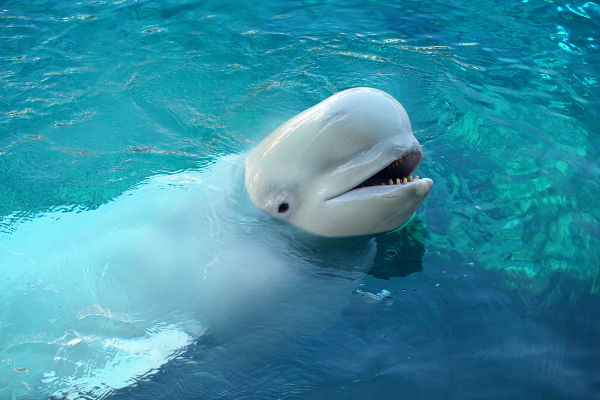The following FoA Opinion article was published on August 19, 2021 on ctexaminer.com
Here we go again—Mystic Aquarium bewildered over the death of a beluga—this time one it recently imported from Canada. The cause of this whale’s death is not known, so the body was sent to University of Connecticut for examination.
So-called “mysterious illnesses” have claimed the lives of belugas at Mystic over the years—Aurora, Winston, Naku, to name a few. They all died despite “extraordinary efforts by aquarium veterinarians and animal care staff.”
It’s time to address the elephant in the room—captivity kills belugas. To prevent these “illnesses” and deaths, simply leave belugas in the ocean. Stop trading them. Stop trying to breed them. Stop making them tourist attractions.
You would think after all these years of “doing research” on belugas that the experts at Mystic would understand what they need to thrive—lots of space and socialization. In the wild, belugas are extremely social. Their pods range from a few belugas to hundreds.
Belugas, which can grow up to 18 feet, inhabit the Arctic and subarctic regions of Russia, Greenland, and North America and navigate in shallow river mouths and estuaries during summer. But during other seasons, they are found in deeper waters, diving to 1,000-meter depths for periods of up to 25 minutes. The deepest recorded dive was to 3,300 feet.
Some populations are strongly migratory and venture more than 600 miles upriver in the Yukon River.
Mystic may boast it has the largest outdoor beluga habitat in the country but it’s not something to be proud of. The 750,000-gallon habitat is really a combination of three different tanks–the main pool is connected to the holding pool and medical pool by a series of three sliding gates. The gates are not always open, so whales do not always have access to the three different tanks.
When I visited last summer, I saw a small, shallow bathtub (it’s only 16.5 feet deep) compared to what they would have in the wild. I wondered how many repetitive circles Mystic’s belugas swim around their tank to equal the miles of waterways stolen from them.
Apparently, I wasn’t the only one— an impatient parent waiting for her child to get a better view of the belugas commented: “They seem to be swimming in similar circles. Circle. Circle. Circle.”
Mystic Aquarium uses research to justify the harm it inflicts on belugas. Its own president has said “you can’t study belugas or other whales in the wild in any substantive way because the technology doesn’t exist.” He claims the studies of whales in the wild are limited to aerial studies and some limited visual studies.
It is alarming how wrong the president of the aquarium is. The game-changing research to help belugas in the wild—for instance the endangered Cook Inlet population–is being done by studying them in the wild because technology is making it easier. And that’s according to the National Oceanic and Atmospheric Administration, which has reported on the first continuous multiyear acoustic monitoring effort across the Cook Inlet. It has provided the most comprehensive description of beluga whale seasonal distribution and feeding behavior to date. This knowledge is critical for understanding and managing potential threats impeding recovery of this endangered population.
The president also ignores new research that allows marine biologists to determine the age, sex, and much more of wild belugas with a small skin sample. The new epigenetic methodology could revolutionize the way scientists study endangered Cook Inlet belugas and provide valuable insights into why the population may not be recovering.
Perhaps Mystic has become more motivated by its own survival than by conservation. It ran a deficit of $2.5 million in 2017, according to its last publicly available tax filing. And the aquarium knows how popular the beluga exhibit is.
That may be why Mystic had posters on display advertising coming attractions, including a beluga encounter where visitors could get “nose to nose” with a beluga for $179.
Before I left, I overheard a child asking her mom where the belugas went because she couldn’t seem them on the surface of the water.
She replied: “They’re down below making other visitors happy,” referring to an area of the tank where there was an underwater viewing area.
I cringed thinking that that is the message that people leave places like Mystic with. That it’s ok for wild animals to be in captivity—as if it’s their responsibility or purpose in life to entertain humans.
As families posed for pictures, I thought to myself—shame on Mystic. A photo op is not research or conservation unless you are researching how to make more money.
Captivity strips wild animals of their dignity and in the case of Havok, ended his life.
“Their sense of self underlies an awareness of their life circumstances in a way that only adds to their suffering,” said Dr. Lori Marino, founder of the Whale Sanctuary Project. “Belugas and other cetaceans remember the arc of their life, where they were, who they knew, what they did, and they can compare that to their life in captivity. I cannot imagine that brings them anything but despair.”
Human animals should be capable of doing better—it’s time to redefine family entertainment.
Nicole Rivard is editor-in-chief/government relations for Darien-Connecticut based Friends of Animals.

